Stewart Island Part III - Ulva Island
Okay. So ends the Stewart Island saga with Part III...finally. As always, there was a bit of a delay, so thanks for hanging in there for the last bit. I was incredibly fortunate with the weather during my stay on the island, and I was especially thankful for this on the last day of my trip. I had planned ot spend the last full day on Ulva Island - the famous wildlife sanctuary just off the coast of Oban - so I was pleased to see that the weather wouldn't get in the way of those plans. I think I've said it before, but even though all of Stewart Island is considered preserved and as close to "100% NZ" as you can get, Ulva Island is much more so. Locals have worked hard to keep all rats, opossums, and cats off of the island so that only native species are present.

Here's a map of the place
I was especially psyched to give it a look and see if I could find some very rare wildlife. I also had a slim chance of seeing a kiwi bird wandering around since they hang out there, but I wasn't counting on it since they're so elusive and because it was the middle of the day. If anyone's dead set on seeing a kiwi in the wild while they're on Stewart Island, there is a guy who takes people out on a boat in the middle of the night to find them. I guess he's figured out where they nest and stays out there until everyone's seen one, guaranteed. The only problem is that it's just a bit pricey for a backpacking budget. By that point, I had been all over the South Island and had to save funds for the way back North, so I had to pass on that experience. Perhaps next time. The particular water taxi that I wanted to take left for Ulva Island at about midday, so that left me plenty of time in the morning to wake up, have breakfast, and plan out my day. It's about ten minutes' off the coast of Golden Bay, so I took a leisurely walk in that direction after a light brunch and plenty of sleep. The charter boat happens to be run by a lovely couple who probably also run half a dozen other things on the island. When I arrived at the dock, the wife was sitting off to the side, doing something complicated with a piece of yarn, so I chatted with her for a few minutes. Then she handed me my round-trip ticket to get onto the boat. It was probably the coolest thing ever.
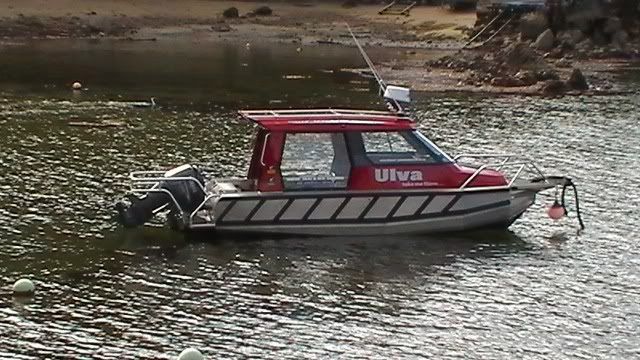

My ticket to get on the water taxi. Brilliant.
I was a little bit early for the boat ride, so I just hung out there and waited for awhile. The boat itself was relatively small - about the size of a standard speed boat - and there were probably ten other people hoping to catch the same boat, so the husband ended up taking us in separate loads. I was in one of the first ones and was very conscious of the threat of Great White Sharks as I crossed the little stretch of water to the island. Our guide invited us to stand out on the bow to get a better view if we wanted, so I obviously had to volunteer and get a better look, nevermind that my hair went everywhere. It took all of five minutes to get over to the island, so I had the entire afternoon to get better acquainted. The skipper warned us that we had until sundown to catch the ferry back to Oban, either one of the four or six o’ clock shuttles. Since it was just after noon, I thought I’d try for the four o’ clock and leave time to get back to town before dark, but I had the whole day to decide.
My first impression upon stepping off the dock was that Ulva was very…pure. I mean, that obviously goes without saying from what I’ve been writing about it so far, but it was quite another thing to see the evidence in person. The beaches were pristine, the forests showed no signs of being trampled, and no matter where you went, the birdsong followed you. It was truly a slice of paradise preserved throughout the generations. I’m told that it takes roughly two hours to walk around the perimeter of the island without stopping, so it wasn’t especially large, but it was just small enough to feasibly cover in that length of time. They dropped us off at a place called Post Office Bay because…it’s where the old post office was during the first European settlement. I guess a boat of mail would come in from the mainland every once in a while, and then the person in charge of the post would raise a flag on Ulva that could be seen from Oban. Then the colonists would know that a shipment had arrived and could pick up parcels and the like. The building remained until 1923, and then the business was moved to the main township.




Arriving on the beach of Ulva Island
I purposely hung back upon arriving to let the rest of the group get further ahead. There were a few different paths that forked out to various parts of the island, so I gave them the chance to spread out along them before venturing on. Even though the wildlife of Ulva are pretty used to humans after continuous exposure, I didn’t want them running away at the sound of a large group approaching. I had much better luck treading lightly through the brush on my own because the birds seemed less intimidated that way.
I still had a faint hope of seeing a kiwi, so the very first bird I saw gave me a jolt of adrenaline as soon as it crossed my path. I couldn’t make out anything but its bulky body digging around in the ferns at first, so I got unnecessarily excited for a brief moment. It had strong, ostrich-like legs for gripping and moving quickly, a reddish-brown coloring to blend in with the dead leaves, and a furtive way of darting in and out of sight to avoid being seen. I was beginning to think that I had gotten unreasonably lucky on the first try. Then its head poked out of the root system, and I realized that it was a Weka, a very similarly-sized bird that resembles a kiwi enough for me to suspect they must be from the same family. Early Europeans used to call them “bush hens,” and the Maori have always admired them for their curiosity and bold personalities. The first one I met was a bit shy and scurried back into the overgrowth right after establishing the fact that it wasn’t a kiwi, but the other ones I encountered tended to be more tactile, sometimes crossing directly in front of me on the paths. Like the kiwi, they are flightless, but I’ve heard that they can actually swim a fair distance and like to travel a lot. The way they peck around on the ground for insects greatly reminded me of chickens, especially when they walked past with a back-and-forth bobbing motion of their heads. I spent a great deal of time trying to spot another one on that side of the island, only to realize that they wander around everywhere on the other side. They became such a common sight that day that I eventually stopped taking pictures of every single one.






The adorable little Weka
I continued on along Flagstaff Point (again, the place where the flag was raised to signal the mail delivery), and then skirted the beach of Sydney Cove. The only thing of interest in that area was a small outhouse and the remnants of a rope swing hanging from a massive tree, so most of the group I had arrived with had gone a short ways down the beach, doubled back, and then entered the rainforest along one of the two or three possible tracks. Since I was interested in keeping as much distance between us as possible, I went even further and walked up and down the whole of Sydney Cove just to make sure that there wasn’t something awesome hidden down the shoreline. Unfortunately, I didn’t happen across any rare finds, but I did have an undisturbed view of several oystercatchers, shellfish, and tide pools. There are apparently several species of penguins that swim along the beaches of the island, but I think they were all out hunting at that time of day. At least half an hour had passed in the time it took me the whole length of the cove and back, so I judged it about time to actually head into the forest.




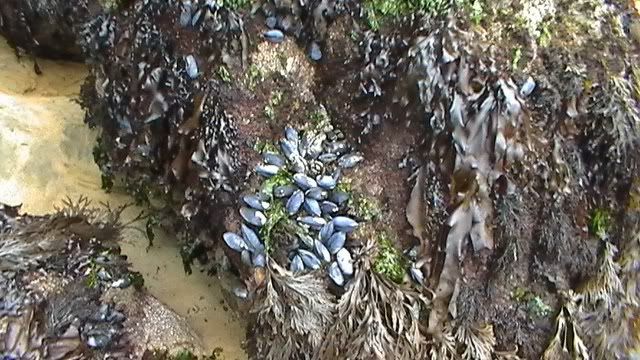

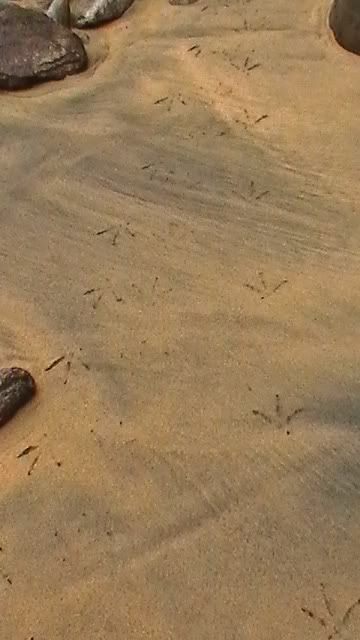

Walking along Sydney Cove
Amazing. That’s all I can say about how cool it was to walk around in that hidden world of leafy canopies and wind-washed wood. I’ve never been in a place that felt so alive with color and energy. The air was practically thrumming with the sounds of life, and even when it was silent, there was a sense of anticipation, as if the forest was merely holding its breath as a prelude for things to come. I tried to preserve this atmosphere by walking very lightly along the path, taking my time to avoid crashing through the brush and ruining the mood.
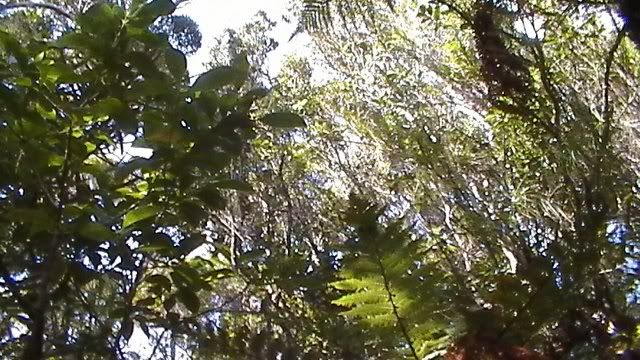


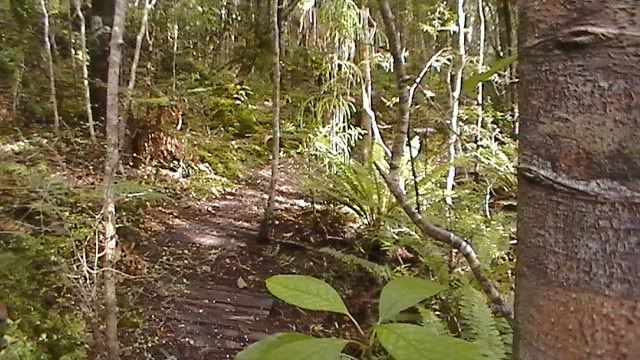
Walking through the forest
Walking along the path like this brought me across my second bird of the morning, the New Zealand Robin. Just like normal robins, these guys are cute, cheerful, and don't really mind humans. At all. They are actually so indifferent about people that some of them have been known to swoop down and perch on your head or shoulder as you pass by. This particular one was no exception. I came across an older couple in front of me on the path, and since they seemed to be stopped looking at something, I took a moment to pause as well. As I watched, the woman scuffed up some of the dirt in front of her with her shoe and then looked expectantly into the brush. Soon enough, this little guy came whizzing out of the trees and landed right on top of her shoe, where he remained sitting for a good few minutes undisturbed. He eventually noticed me further down the trail and hopped off in my general direction. I have a great close-up video of it pecking at my toes and darting around on the ground, but it’s too large to put here. I saw several more robins while on Ulva, but this little guy stood out as the friendliest one.



The cute New Zealand Robin, Stewart Island variety
I was still not too far from the former post office site at that point, so I decided to pick up the pace a bit and head towards the middle of the island. The guidebook I had bought in Oban was great for pointing out the species of native trees and little fun facts, but unfortunately, I seem to have shipped it home in one of my packages by mistake. I do remember one particular passage, however, that talked about a certain kind of white worm that lived on the trees. Apparently they secrete “honeydew” from their bums after feeding off the bark, and that nectar attracts all sorts of birds. Unfortunately, it also attracts wasps, which fly around taking it all and impacting the diet of local wildlife. The bottom line was the same sort of thing that I’ve repeated over and over again already - that it’s a sanctuary and all of that. The book was quite handy when I came across birds like my next find.
Just as I was crossing a footbridge, I happened to glance to my right and see a gorgeous South Island Saddleback. They’re so-called because of the distinctive red-orange markings on their backs that make it look like they’re wearing a harness. This guy was especially noisy and kept bouncing around from branch to branch in front of me. I recently found out that the Maori consider Saddlebacks good omens when their cries are heard from the right and bad omens if heard from the left. I think they should just turn around and walk backwards if that happens, but...hmm. Apparently they consider them cheeky because one story talks of how a certain god who had tried to capture the sun asked one to get him some water. The Saddleback rudely pretended not to hear him, so the angry god grabbed him with one burning hand and left a fiery brand across its back.


The New Zealand Saddleback
Another bird that I had been hearing (but rarely seeing) quite a bit of during my stay on Stewart Island was the New Zealand Wood Pigeon. I say "pigeon," but these things were massive. And they definitely didn't poke along quietly making little cooing sounds. I first heard one during my walk in Fern Gully, and I was half-convinced that someone had just thrown a boomerang at me. Their wings make a distinctive "whoo-whoo-WHOO" noise, kind of like the rotor blades of a helicopter, and make it impossible to miss one coming from ages away. Despite that, I found it incredibly difficult to actually get one on camera because the echo effect of the woods made it seem like one was coming from every imaginable direction.


The clearer one is from Google. The second is my attempt.
I was pretty deep into the forest by this point, so I hadn’t run into any people for quite some time. I’m really glad that I didn’t do the four-hour guided tour option for $50-80 because I ended up spending about that amount of time on the island anyway and wasn’t restricted by a large group. I could just go wherever I wanted, and the handy guidebook helped me along with anything that I didn’t know. Since that was all of $5 at the gift shop, it was a major savings. I ran across a few of these groups while I was walking around by the beach, and the two things that struck me about them was the noise and slow pace. They were mostly older people taking their time while a guide went on about a certain type of fungus. I don’t doubt that they’re very informative, but I have to wonder how many birds they saw with how conspicuous they were. I was probably a little too cautious due to the fact that I was still holding out for a kiwi, so I was walking at about a third of my normal speed to minimize noise. That ended up costing me a little bit because it was suddenly nearly 3pm before I knew it, and I still had a large chunk of the island to cover. Determined to at least make it to the beach on the other side, I snapped a few more photos and kept going.




More amazing forest shots
Unfortunately, I didn’t make it down to the Snuggery or Roger Bay on the southern part of the island, but I did my best to power on to Boulder Beach. The little bit between Sydney Cover and Boulder Beach took a deceptively long time to walk through with lots of trails weaving in and out of the ferns. Some were on quite an incline as well, so people with health problems probably don’t get too far in there. I got sidetracked a few times by some “deer paths” that looked like they could have gone someplace but were actually just the trails used by naturalists to set rat/opossum snares. I had a brief moment of panic when I looked down at my watch and saw that it was already 3 o’ clock. The boat left Flagstaff Point at 4pm, and as much fun as I was having, I didn’t really want to stay until 6pm and come back in the dark. For one thing, it was getting quite cold, and I was in need of some dinner. I passed a sign close to Boulder Beach proclaiming Sydney Cove to be about 45 minutes away by foot, so I was cutting it pretty close. I scrambled down the slope leading to the beach and managed to snatch up a few quick pictures before heading back. One particularly friendly Weka nearly walked across my foot while I was standing there.




Boulder Beach
Then it was literally a race back to the boat. I had a feeling it wouldn’t leave right at 4pm since it would most likely require multiple trips, but I didn’t want to risk it. I didn’t bother stopping along the way and just ran for it. It was quite impressive, actually. I think they were instances when I was briefly airborne. I think, all in all, it took me about 15 minutes to go from one side to the other, so take that, guided maps. Thank God the trails were all empty, too, because I could have easily plowed into someone on the sharp turns. There was one…ahem interesting sight, however, that made me pause and whip out my camera one last time. I slowly became aware of a strange sound mixed in with my own breathing, so I slowed down to catch my bearings and look around. And what I saw was a pair of Kakas going at it in the tree next to me. Quite vigorously. Yeah. I was torn between awkwardness and curiosity. Curiosity won. What I didn’t consider was how long they then continued at it, but just when I was about to cut my losses and jog on, they, ah, finished up and separated. Hmm. Felt a bit dirty, but oh, the wonders of nature.


Ahem
I made it back to the harbor with five minutes to spare and re-joined several of the couples who had set off in the same boat earlier in the day. It sounded like everyone had an amazing time, and I wasn’t the only one who didn’t see a kiwi. Oh well. Next time, I suppose. The ride back to Stewart Island was fairly uneventful, with one exception. Just as we were getting back into Oban, I happened to look out the back and see this humongous albatross gliding behind us. I’ve heard about how they have a massive wingspan and all of that, but this thing was like a condor swooping over the water. Very cool. It made me think of reading “Rhyme of the Ancient Mariner” in high school and how some idiot was doomed to wear a dead one around his neck as punishment for shooting it. For those of you who haven’t read it, it’s an old superstition that albatrosses are the spirits of dead sailors, so killing one is supposed to be incredibly unlucky. This one was perfectly healthy, though, and continued cruising along beside us as we made port.
And that was pretty much it for the last day. I walked down to the water at sunset with the Scottish girl again just to see if we could spot the penguins coming ashore, but no luck, I’m afraid. Don’t worry, I have a penguin story for you later. Stay tuned and I will continue on to my travels in Dunedin. Thanks for reading!